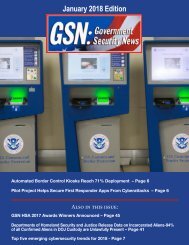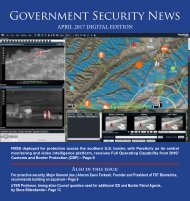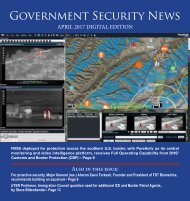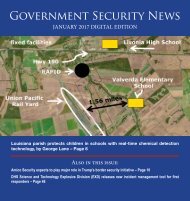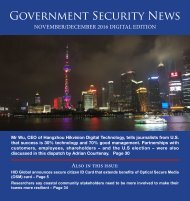Government Security News February 2017 Digital Edition
Create successful ePaper yourself
Turn your PDF publications into a flip-book with our unique Google optimized e-Paper software.
“Expedited removal” of noncitizens called for<br />
in President’s January 25 executive order<br />
President Trump’s January<br />
25, <strong>2017</strong>, executive<br />
order directs the Department<br />
of Homeland <strong>Security</strong><br />
(DHS) to dramatically<br />
expand the use of<br />
“expedited removal.” Created<br />
in 1996, expedited<br />
removal is a process by<br />
which low-level immigration<br />
officers can quickly<br />
deport certain noncitizens<br />
who are undocumented or<br />
have committed fraud or misrepresentation.<br />
Since 2004, immigration<br />
officials have used expedited removal<br />
to deport individuals who arrive<br />
at our border, as well as individuals<br />
who entered without authorization<br />
if they are apprehended within<br />
two weeks of arrival and within 100<br />
miles of the Canadian or Mexican<br />
border.<br />
One of the major problems with<br />
expedited removal is that the immigration<br />
officer making the decision<br />
virtually has unchecked authority.<br />
Individuals subject to expedited<br />
removal rarely see the inside of a<br />
courtroom because they are not afforded<br />
a regular immigration court<br />
hearing before a judge. In essence,<br />
the immigration officer serves both<br />
as prosecutor and judge. Further,<br />
given the speed at which the process<br />
takes place, there is rarely an opportunity<br />
to collect evidence or consult<br />
with an attorney, family member, or<br />
friend before the decision is made.<br />
Such a truncated process means<br />
there is a greater chance that persons<br />
are being erroneously deported<br />
from the United States, potentially<br />
to imminent harm or death. Moreover,<br />
individuals who otherwise<br />
might qualify for deportation relief<br />
if they could defend themselves<br />
in immigration court are unjustly<br />
deprived of any opportunity to do<br />
so. Yet expedited removal has been<br />
33<br />
increasingly applied in<br />
recent years; 44 percent<br />
of all removals from the<br />
United States were conducted<br />
through expedited<br />
removal in Fiscal Year<br />
(FY) 2013, the most recent<br />
government data available.<br />
A dramatic expansion,<br />
as directed by President<br />
Trump, might result<br />
in thousands of additional<br />
deportations without due process.<br />
What the Law Says<br />
“Expedited removal” refers to the<br />
legal authority given to even lowlevel<br />
immigration officers to order<br />
the deportation of some non-U.S.<br />
citizens without any of the dueprocess<br />
protections granted to most<br />
other people—such as the right to<br />
an attorney and to a hearing before<br />
a judge. The Illegal Immigration<br />
and Immigrant Responsibility Act<br />
of 1996 created expedited removal,<br />
but the federal government subsequently<br />
expanded it significantly.<br />
As it now stands, immigration officers<br />
can summarily order the removal<br />
of nearly any foreign national




